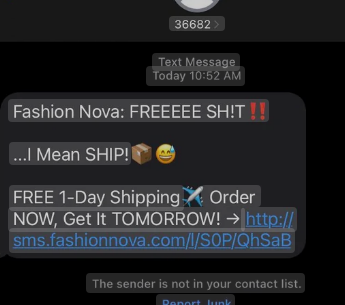A flurry of reports and online discussions have recently centered around a specific short code: 36682. If you’ve received a 36682 text message, you’re not alone. This five-digit number is a source of both legitimate business communication and a wave of unsolicited messages, leaving many to wonder about its origins and intent. This article delves into what we know about the 36682 text message, its known uses, and how to handle these communications.
What is a Short Code and Why is 36682 Significant?

Short codes are five or six-digit numbers used by businesses to send and receive text messages at a large scale, a practice known as Application-to-Person (A2P) messaging. They are often used for marketing promotions, appointment reminders, order confirmations, and two-factor authentication.
The short code 36682 has gained prominence due to the sheer volume of messages originating from it across various countries, with a particularly high level of activity reported in the United States.
The Legitimate Side of the 36682 Text Message
For many consumers, a 36682 text message is a perfectly normal and expected communication. One of the most frequently cited legitimate users of this short code is the popular online fashion retailer, Fashion Nova. Customers often receive order confirmations, shipping updates, and promotional materials from this number.
These messages are typically solicited, meaning the customer has provided their phone number to the company at some point, whether during a purchase or by opting into a marketing list.
The Concerning Rise of Unsolicited Messages
However, a significant number of individuals have reported receiving unsolicited 36682 text message communications. These messages often take on the characteristics of spam or even phishing attempts. Users have reported receiving unexpected notifications about orders they never placed, suspicious links to track packages, or vague marketing messages from unknown sources.
This dual use of the 36682 short code is what causes confusion and concern. It’s plausible that scammers are “spoofing” the number—making it appear as though the message is coming from 36682 when it’s not—or that the short code is being used by multiple entities, some less scrupulous than others.
Initial online speculation also linked the number to Cox Communications, but it has been clarified that Cox utilizes a different short code (73153) for its customer communications.
Identifying a Suspicious 36682 Text Message
Given the mixed reports, it’s crucial to approach any unexpected 36682 text message with caution. Here are some red flags to watch out for:
- Unexpected Order Confirmations: If you receive a message about an order from a company you’ve never shopped with, it’s likely a scam.
- Suspicious Links: Be wary of any links in the message, especially if they are shortened or don’t clearly lead to a reputable company’s website. Phishing scams often use fake login pages to steal your personal information.
- Urgent Calls to Action: Messages that create a sense of urgency, such as “Your account will be suspended” or “Click now to claim your prize,” are common tactics used by scammers.
- Requests for Personal Information: Legitimate companies will rarely ask for sensitive information like passwords, credit card numbers, or social security numbers via text message.
What to Do If You Receive a Suspicious Message
If you receive a 36682 text message that you believe to be spam or a phishing attempt, follow these steps:
- Do Not Reply: Replying to a spam message, even with “STOP,” can confirm that your phone number is active, potentially leading to more unwanted texts.
- Do Not Click on Any Links: This is the most critical step to protect yourself from malware and phishing sites.
- Block the Number: You can easily block the number on your smartphone to prevent further messages.
- Report the Message: You can report the message as junk or spam directly through your messaging app. You can also forward the message to 7726 (which spells “SPAM” on a keypad), a service used by most major US wireless carriers to track and block spam.
- File a Complaint: For more serious attempts at fraud, you can file a complaint with the Federal Trade Commission (FTC) at ftc.gov/complaint.
While the 36682 text message can be a legitimate form of communication from businesses you know and trust, the prevalence of unsolicited messages means it’s essential to remain vigilant. By being aware of the potential for scams and knowing how to respond, you can protect your personal information and reduce the annoyance of unwanted texts.


